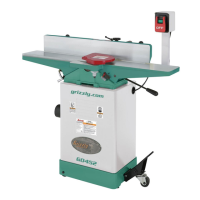-34-
Model G0452/P/Z (Mfg. Since 08/12)
To edge joint on the jointer:
1. Read and understand SECTION 1: SAFETY,
beginning on Page 7.
2. Make sure your stock has been inspected
for dangerous conditions as described in the
Stock Inspection instructions, beginning on
Page 31.
3. Set the cutting depth for your operation. (We
suggest between
1
⁄16" and
1
⁄8" for edge joint-
ing, using a more shallow depth for hard
wood species or for wide stock.)
4. Make sure the fence is set to 90˚.
5. If your workpiece is cupped (warped), place it
so the concave side is face down (Figure 46)
on the surface of the infeed table.
6. Start the jointer.
7. Press the workpiece against the table and
fence (Figure 45) with firm pressure. Use
your trailing hand to guide the workpiece
through the cut, and feed the workpiece over
the cutterhead.
Note: When your leading hand gets within
4" of the cutterhead, lift it up and over the
cutterhead, and place it on the portion of
the workpiece that is over the outfeed table.
Now, focus your pressure on the outfeed end
of the workpiece while feeding, and repeat
the same action with your trailing hand when
it gets within 4" of the cutterhead. To keep
your hands safe, DO NOT let them get closer
than 4" from the cutterhead when it is mov-
ing!
8. Repeat Step 7 until the entire edge is flat.
Note: If 2nd edge is jointed it will not likely be
parallel with the 1st, so instead of jointing the
second edge, trim it with a table saw. This
will ensure both edges are parallel with each
other.
The purpose of bevel cutting is to cut a specific
angle into the edge of a workpiece (see Figures
47 & 48).
The Model G0452 has preset fence stops at 45˚
inward, 90˚, and 45˚ outward (135˚). If your situ-
ation requires a different angle, the preset fence
stops can be easily adjusted for your needs.
Figure 48. Illustration of bevel cutting results.
Figure 47. Typical bevel cutting operation.
Bevel Cutting
If you are not experienced with a jointer,
set the depth of cut to 0", and practice
feeding the workpiece across the tables as
described below. This procedure will better
prepare you for the actual operation.

